JFS Newsletter No.86 (October 2009)
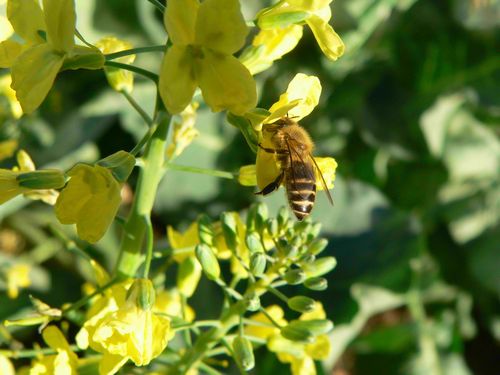
Copyright Ginza Bee Project
Ranked with the Fifth Avenue shopping district in New York City, Japan's Ginza district in Tokyo is one of the world's leading downtown districts, complete with high-class department stores and designer shops. Today, bee honey collected from hives there is starting to attract people's attention. Ginza honeybees are nicknamed "Ginpachi" (short for "Ginza bees" in Japanese), and recently they have become somewhat of a new mascot for the district.
A five-minute walk from the intersection of Ginza 4-chome will take you to a building where, on the rooftop 45 meters above, you'll find some honeybee hives. The beekeepers are using the honey to make Ginza-based products using local skills. For example, delicious sweets and confectionaries are whipped up by local pastry chefs using the honey collected, and then put on display for sale in the showcases of local shops. Some of the beeswax is also made into candles for use at the Ginza Church's Christmas Mass.
Birth of the Ginza Bee Project
This outstanding project is administrated by a non-profit organization called the Ginza Bee Project, which is run by volunteers of Ginza Shokugakujuku, a group that regularly holds seminars on food sources and diet, and those of the Ginza Town Study Group, a group focused on studying the history and culture of the area.
The aim of the project is to interact with the local environment and ecosystems in Ginza through beekeeping. Although Ginza, which is located in the middle of Tokyo, has some small green areas, these groups are trying to learn more about how a sustainable society and the local environment operates by working with honeybees and using the honey they produce.
At the beginning of the project, in late 2005, some people had concerns that it might be dangerous to keep honeybees in the densely populated urban district, because they thought the bees might attack people, but honeybees are generally gentle creatures, and they never attack unless suddenly surprised. After thoroughly explaining the nature of honeybees to the tenants of the building where the hives were to be installed, in March 2006, the project members placed three hives on the building's rooftop, and the bees began flying into the sky above Ginza.
Is it really possible to keep honeybees and collect honey in an urban area such as Ginza? Many were suspicious. Honeybees are said to fly within a three- to four-kilometer radius from their hives to collect nectar. Fortunately, parks rich in green space are located within two kilometers, such as the Imperial Palace, Hibiya Park, and Hama-rikyu Gardens. Furthermore, many roadside trees are also good sources of nectar. The amount of honey collected has been increasing steadily, growing from 160 kilograms (kg) in 2006, to 290 kg in 2007, 440 kg in 2008, and over 700 kg in 2009.
The honeybee is said to be an environmental indicator species because it is extremely susceptible to pesticides, which are used on vast areas of farmland in Japan, and are causing the survival rate of bees to drop. Meanwhile, in Ginza, which is in the central part of metropolitan Tokyo, the use of pesticides is avoided because of the growing number of people with allergies. So Ginza has ended up being a bee-friendly environment, and the high-quality honey-producing Ginza bees have made people aware that the district has a rich natural environment.
Since the bees were brought to Ginza, cherry blossoms that had previously not been pollinated began to produce cherries. People began to see birds eating the cherries, and small insects began rejuvenating the environment around the area.
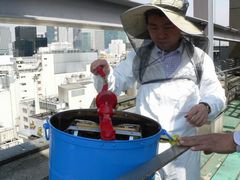
Collecting Honey
Copyright Ginza Bee Project
The extraordinary combination of Ginza and honeybees has attracted attention from the public and media since the start of the project, and more and more people are enjoying Ginza honey. People began thinking of not only the bees and the honey they produce in Ginza but also the natural environment around the whole region.
Ginza Green Project Focused on Growing Local, Eating Local
The existence of bees in Ginza has gradually become known by most people in the area, and some who were only interested in honey before began to take notice of their local environment. In order to provide a more comfortable environment for the bees, the Ginza Green Project was launched in 2007, with the aim of creating flower and vegetable gardens on building rooftops to increase the amount of green space sources of nectar for them. This project was actually started on the roof of Matsuya Co., a department store in Ginza, with the cooperation of Masaki ENVEC Co., a rooftop-gardening company.
The project's objectives are not only to produce honey but also to reduce the negative impacts of the urban heat-island effect, by which concrete and roads retain heat from the sun and increase local temperatures. The aim is also to realize a "grow local, eat local" ethic in the true sense by collecting the honey that Ginza bees produce from local nectar sources, and making food and sweets using the honey harvested from the rooftop plot. It also aims to encourage person-to-person relationships among people who many have otherwise been complete strangers.
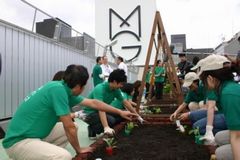
Rooftop garden of Matsuya
Copyright Ginza Bee Project
Today, 30 employees from Matsuya and its partner companies are helping with the rooftop garden as after-work volunteers. According to spokesman Yukio Oki, employees other than members are also starting to care about how the vegetables are growing, which proves the company's success in raising environmental awareness. Matsuya often gets words of encouragement from its customers about its activities on the rooftop, which is open to the public. The company plans to sell sweets and bread using the herbs grown on its rooftop to achieve the goal of growing locally and eating locally.
With interest growing in the Ginza Green Project, various people -- including students and people from the Ministry of Agriculture, Forestry and Fisheries -- are frequently visiting the project sites. Besides the Matsuya department store, Ginza Blossom (a wedding hall), an art gallery, and some commercial establishments are now participating. They grow a variety of things on their rooftops, like herbs for cooking, rice for brewing sake, fruit for sweets, and green soybeans to be served as snacks at high-class bars, so the Ginza Green Project is expanding further while involving a growing number of neighbors.
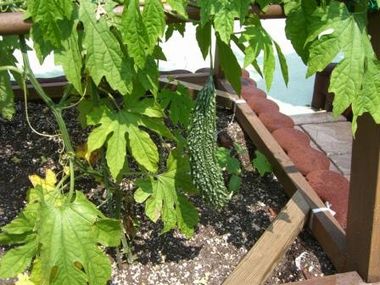
Copyright Ginza Bee Project
Japanese Honeybees
Three of the beehives brought to Ginza in March 2006 were populated by European honeybees, first introduced to Japan in the Meiji period (1868-1912). Because the European honeybees are better at producing honey, they have been playing a central role in beekeeping in Japan, and many Japanese beekeepers raise them.
Indigenous Japanese honeybees, in contrast, produce less honey and are more difficult to raise, so they are considered inferior to European honeybees from an apicultural point of view. Recently, however, it has become better understood that Japanese honeybees are skilled at fighting hornets, a natural enemy of European honeybees. Furthermore, Japanese honeybees are more disease-resistant and tolerant to extremes of heat and cold, which are attributes better suited to Japan's natural environment.
Japanese honeybees have generally been considered to be pests, and are often exterminated when they build beehives in street-side trees or in residential areas, but in 2007 the Ginza Bee Project started an initiative to conserve Japanese honeybees by rescuing them from extermination and raising them in Ginza.
Creating a Ginza "Satoyama"
Ginza was one of the first districts in Japan to introduce Western technology such as brick construction and street gaslights. Since the time when Edo, Japan's former capital, was renamed Tokyo, Ginza has always been ahead of the times, while still preserving Japanese history and culture. When a number of high-rise buildings were constructed under redevelopment projects in various parts of Tokyo, Ginza held extensive talks with Chuo Ward, which has local jurisdiction, before the ward finally established an ordinance in 2006 to set the maximum height of buildings at 56 meters in the Ginza district.
"Our future vision for Ginza is not a place where buildings compete for height, but where people and even small insects can coexist in harmony with nature," said Atsuo Tanaka, co-founder of the Ginza Bee Project. "We believe that honeybees and people's appreciation for them will help to create an urban district full of greenery, just like the "satoyama" of old (traditional nature-rich rural landscapes near villages). We would be happy if our project could be of some help for future urban planning in Japan," he said.
Many people are really looking forward to seeing how the Ginza Bee Project continues to evolve in Ginza's urban "satoyama," and also to seeing lots of honeybees flying around.
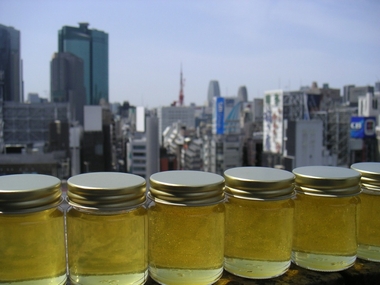
Copyright Ginza Bee Project
Written by Yuriko Yoneda

No comments:
Post a Comment